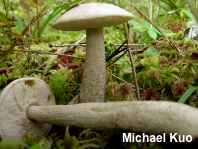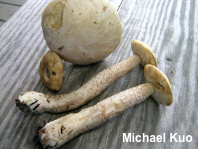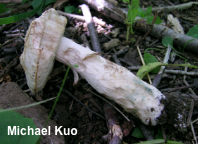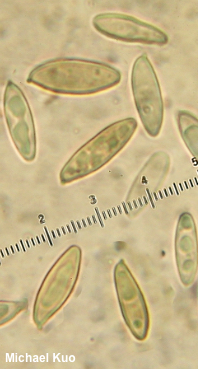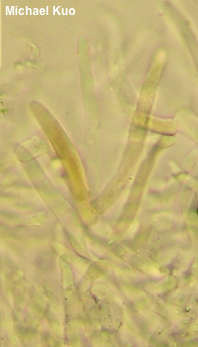| Major Groups > Boletes > Leccinum > Leccinum holopus |

|
Leccinum holopus [ Basidiomycota > Boletales > Boletaceae > Leccinum . . . ] by Michael Kuo This is a circumboreal species, found pretty much wherever white birch trees (Betula papyrifera and Betula pendula) grow. Leccinum holopus has a pale brown to white cap, and its stem is adorned with whitish to brown (or nearly black) scabers. Some forms of the species become bluish-stained at the stem base, and/or have flesh that stains slowly pinkish when sliced; in other forms no staining occurs. Leccinum albellum is very similar, but is associated with oaks rather than birches. Its stem is often a bit more slender—but if you are not sure what kind of tree your Leccinum was associated with, microscopic examination will quickly sort things out, since the pileipellis of Leccinum holopus is a cutis, as opposed to the epithelium of Leccinum albellum. Leccinum nucatum is a synonym. Leccinum holopus var. americanum, which was separated by Smith & Thiers (1971) on the basis of its slightly reddening flesh, does not differ in DNA from Leccinum holopus var. holopus. Thanks to Gerry Adams for collecting Leccinum holopus for study; his collection is deposited in The Herbarium of Michael Kuo. Description: Ecology: Mycorrhizal with birches (in North America with paper birch, in Europe and Asia with European white birch); appearing alone or gregariously; summer and fall; widely distributed in northern North America from roughly the 43rd parallel northward (but also found under water birch in the Rocky Mountains); also known from northern Europe. The illustrated and described collections are from Colorado, Michigan, and Wisconsin. Cap: 2–7 cm; convex, becoming broadly convex; sticky or dry (sometimes becoming more sticky with age); bald; pale brownish to nearly white; discoloring and aging brownish or, in wet conditions, pinkish or bluish; margin with a very tiny sterile overhang. Pore Surface: Creamy white, bruising a little brownish; 2–4 circular pores per mm; tubes to 12 mm deep; by maturity depressed at the stem. Stem: 4–15 cm long; 1–2 cm thick; equal, or with a tapering apex; finely scabrous with whitish to brownish, brown, or nearly black scabers; ground color whitish; sometimes staining blue near the base. Flesh: White; not staining on exposure, or staining slowly pinkish (allow up to half an hour); sometimes bluing a little in the stem base. Odor and Taste: Not distinctive. Chemical Reactions: Ammonia pink on cap surface; pinkish on flesh. KOH red or negative on cap surface; negative on flesh. Iron salts negative on cap surface; bluish or negative on flesh. Spore Print: Brown. Microscopic Features: Spores 14–19 x 4–6.5 µm; fusiform; smooth; hyaline to yellowish in KOH. Basidia to about 30 x 10 µm; clavate; 4-sterigmate. Hymenial cystidia 30–50 x 7.5–12.5 µm; variously shaped but primarily lageniform; smooth; thin-walled; hyaline in KOH. Pileipellis a cutis or collapsing trichoderm of elements 4–7.5 µm wide, smooth, thin-walled, hyaline or golden (especially the terminal cells) in KOH; terminal elements cylindric with rounded or subacute apices. Caulocystidia in bundles with caulobasidia; variously shaped but often lageniform with a long neck; up to 75 x 20 µm; hyaline to yellowish in KOH. REFERENCES: (Rostkovius, 1844) Watling, 1960. (1947; Smith, Thiers & Watling, 1967; Snell & Dick, 1970; Smith & Thiers, 1971; Grund & Harrison, 1976; Phillips, 1981; Smith, Smith & Weber, 1981; Breitenbach & Kränzlin, 1991; Phillips, 1991/2005; Schalkwijk-Barendsen, 1991; Both, 1993; Lannoy & Estades, 1995; Barron, 1999; Bessette et al., 2000; Nonis, 2001; Binder & Hibbett, 2004; den Bakker et al., 2004a, 2004b; den Bakker & Noordeloos, 2005; McNeil, 2006; Kuo, 2007; Buczacki et al., 2012; Kuo & Methven, 2014; Bessette et al., 2016; Noordeloos & den Bakker, 2018; Kuo & Ortiz-Santana, 2020.) Herb. Kuo 09080103, 09120402, 09150707. Herb. DBG RMNP 2008-117, RMNP 2009-042. Herb. EIU ASM 8267. This site contains no information about the edibility or toxicity of mushrooms. |
© MushroomExpert.Com |
|
Cite this page as: Kuo, M. (2020, January). Leccinum holopus. Retrieved from the MushroomExpert.Com Web site: http://www.mushroomexpert.com/leccinum_holopus.html |
